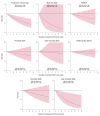Association of maternal, obstetric, fetal, and neonatal mortality outcomes with Lady Health Worker coverage from a cross-sectional survey of >10,000 households in Gilgit-Baltistan, Pakistan
- PMID: 38412169
- PMCID: PMC10898742
- DOI: 10.1371/journal.pgph.0002693
Association of maternal, obstetric, fetal, and neonatal mortality outcomes with Lady Health Worker coverage from a cross-sectional survey of >10,000 households in Gilgit-Baltistan, Pakistan
Abstract
Pakistan has among the highest rates of maternal, perinatal, and neonatal mortality globally. Many of these deaths are potentially preventable with low-cost, scalable interventions delivered through community-based health worker programs to the most remote communities. We conducted a cross-sectional survey of 10,264 households during the baseline phase of a cluster randomized controlled trial (cRCT) in Gilgit-Baltistan, Pakistan from June-August 2021. The survey was conducted through a stratified, two-stage sampling design with the objective of estimating the neonatal mortality rate (NMR) within the study catchment area, and informing implementation of the cRCT. Study outcomes were self-reported and included neonatal death, stillbirth, health facility delivery, maternal death, postpartum hemorrhage (PPH), and Lady Health Worker (LHW) coverage. Summary statistics (proportions and rates) were weighted according to the sampling design, and mixed-effects Poisson regression was conducted to explore the relationship between LHW coverage and maternal/newborn outcomes. We identified 7,600 women who gave birth in the past five years, among whom 13% reported experiencing PPH. The maternal mortality ratio was 225 maternal deaths per 100,000 live births (95% confidence interval [CI] 137-369). Among 12,376 total births, the stillbirth rate was 41.4 per 1,000 births (95% CI 36.8-46.7) and the perinatal mortality rate was 53.0 per 1,000 births (95% CI 47.6-59.0). Among 11,863 live births, NMR was 16.2 per 1,000 live births (95% CI 13.6-19.3) and 65% were delivered at a health facility. LHW home visits were associated with declines in PPH (risk ratio [RR] 0.89 per each additional visit, 95% CI 0.83-0.96) and late neonatal mortality (RR 0.80, 95% CI 0.67-0.97). Intracluster correlation coefficients were also estimated to inform the planning of future trials. The high rates of maternal, perinatal, and neonatal death in Gilgit-Baltistan continue to fall behind targets of the 2030 Sustainable Development Goals.
Copyright: © 2024 Farrar et al. This is an open access article distributed under the terms of the Creative Commons Attribution License, which permits unrestricted use, distribution, and reproduction in any medium, provided the original author and source are credited.
Conflict of interest statement
The authors have declared that no competing interests exist.
Figures


Similar articles
-
An integrated newborn care kit (iNCK) to save newborn lives and improve health outcomes in Gilgit Baltistan (GB), Pakistan: study protocol for a cluster randomized controlled trial.BMC Public Health. 2023 Dec 11;23(1):2480. doi: 10.1186/s12889-023-17322-y. BMC Public Health. 2023. PMID: 38082395 Free PMC article.
-
Improvement of perinatal and newborn care in rural Pakistan through community-based strategies: a cluster-randomised effectiveness trial.Lancet. 2011 Jan 29;377(9763):403-12. doi: 10.1016/S0140-6736(10)62274-X. Epub 2011 Jan 14. Lancet. 2011. PMID: 21239052 Clinical Trial.
-
Predictors and disparities in neonatal and under 5 mortality in rural Pakistan: cross sectional analysis.Lancet Reg Health Southeast Asia. 2023 Jun 21;15:100231. doi: 10.1016/j.lansea.2023.100231. eCollection 2023 Aug. Lancet Reg Health Southeast Asia. 2023. PMID: 37614356 Free PMC article.
-
Community-based maternal and newborn educational care packages for improving neonatal health and survival in low- and middle-income countries.Cochrane Database Syst Rev. 2019 Nov 5;2019(11):CD007647. doi: 10.1002/14651858.CD007647.pub2. Cochrane Database Syst Rev. 2019. PMID: 31686427 Free PMC article.
-
Care prior to and during subsequent pregnancies following stillbirth for improving outcomes.Cochrane Database Syst Rev. 2018 Dec 17;12(12):CD012203. doi: 10.1002/14651858.CD012203.pub2. Cochrane Database Syst Rev. 2018. PMID: 30556599 Free PMC article.
Cited by
-
The nexus between healthcare provider distribution and neonatal mortality based on the context of maternal and child healthcare services in Pakistan.J Health Popul Nutr. 2025 Jun 21;44(1):219. doi: 10.1186/s41043-025-00971-7. J Health Popul Nutr. 2025. PMID: 40544296 Free PMC article.
-
Estimation of unconfirmed COVID-19 cases from a cross-sectional survey of >10 000 households and a symptom-based machine learning model in Gilgit-Baltistan, Pakistan.BMJ Public Health. 2025 Apr 28;3(1):e001255. doi: 10.1136/bmjph-2024-001255. eCollection 2025. BMJ Public Health. 2025. PMID: 40302730 Free PMC article.
References
-
- United Nations Statistics Division. The Sustainable Development Goals Extended Report 2022—Goal 3: Good Health and Well-being [Internet]. Department of Economic and Social Affairs; 2023. [cited 2023 Feb 23]. Available from: https://unstats.un.org/sdgs/report/2022/extended-report/Extended-Report_....
-
- Trends in maternal mortality 2000 to 2020: estimates by WHO, UNICEF, UNFPA, World Bank Group and UNDESA/Population Division. Geneva: World Health Organization; 2023.
-
- GBD 2019 Under-5 Mortality Collaborators. Global, regional, and national progress towards Sustainable Development Goal 3.2 for neonatal and child health: all-cause and cause-specific mortality findings from the Global Burden of Disease Study 2019. Lancet. 2021 Sep 4;398(10303):870–905. - PMC - PubMed
-
- Levels & trends in child mortality: report 2022. New York: United Nations Children’s Fund (UNICEF); 2023.
-
- National Institute of Population Studies—NIPS/Pakistan, ICF. Pakistan Demographic and Health Survey 2017–18 [Internet]. Islamabad, Pakistan: NIPS/Pakistan and ICF; 2019. Available from: http://dhsprogram.com/pubs/pdf/FR354/FR354.pdf.
LinkOut - more resources
Full Text Sources
Miscellaneous
